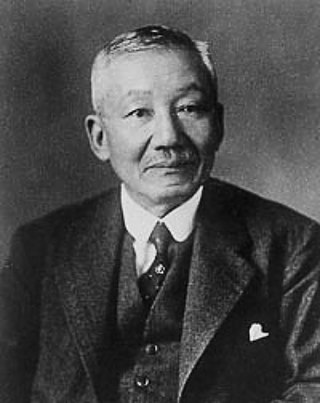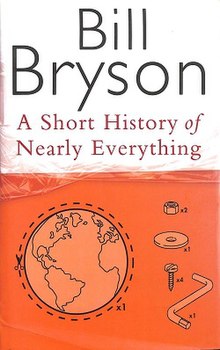
William McGuire Bryson is an American–British journalist and author. Bryson has written a number of nonfiction books on topics including travel, the English language, and science. Born in the United States, he has been a resident of Britain for most of his adult life, returning to the U.S. between 1995 and 2003, and holds dual American and British citizenship. He served as the chancellor of Durham University from 2005 to 2011.

Jared Mason Diamond is an American geographer, historian, ornithologist, and author best known for his popular science books The Third Chimpanzee (1991); Guns, Germs, and Steel ; Collapse (2005), The World Until Yesterday (2012), and Upheaval (2019). Originally trained in biochemistry and physiology, Diamond is known for drawing from a variety of fields, including anthropology, ecology, geography, and evolutionary biology. He is a professor of geography at UCLA.

In marine geology, a guyot, also called a tablemount, is an isolated underwater volcanic mountain (seamount) with a flat top more than 200 m (660 ft) below the surface of the sea. The diameters of these flat summits can exceed 10 km (6.2 mi). Guyots are most commonly found in the Pacific Ocean, but they have been identified in all the oceans except the Arctic Ocean. They are analogous to tables on land.

Michio Kaku is a Japanese-American theoretical physicist, activist, futurologist, and popular science writer. He is a professor of theoretical physics in the City College of New York and CUNY Graduate Center. Kaku is the author of several books about physics and related topics and has made frequent appearances on radio, television, and film. He is also a regular contributor to his own blog, as well as other popular media outlets. For his efforts to bridge science and science fiction, he is a 2021 Sir Arthur Clarke Lifetime Achievement Awardee.

Robert Maurice Lipson Winston, Baron Winston, is a British professor, medical doctor, scientist, television presenter and Labour peer.

A Walk in the Woods: Rediscovering America on the Appalachian Trail is a 1998 travel book by the writer Bill Bryson, chronicling his attempt to thru-hike the Appalachian Trail during the spring and summer of 1996. For much of his journey, Bryson was accompanied by his friend Matt Angerer, who had previously appeared in Bryson's 1991 book Neither Here nor There: Travels in Europe.
The Royal Society Science Books Prize is an annual £25,000 prize awarded by the Royal Society to celebrate outstanding popular science books from around the world. It is open to authors of science books written for a non-specialist audience, and since it was established in 1988 has championed writers such as Stephen Hawking, Jared Diamond, Stephen Jay Gould and Bill Bryson. In 2015 The Guardian described the prize as "the most prestigious science book prize in Britain".
The year 1936 in science and technology involved some significant events, listed below.

Hantaro Nagaoka was a Japanese physicist and a pioneer of Japanese physics during the Meiji period.

A science book is a work of nonfiction, usually written by a scientist, researcher, or professor like Stephen Hawking, or sometimes by a non-scientist such as Bill Bryson. Usually these books are written for a wide audience presumed to have a general education rather than a specifically scientific training, as opposed to the very narrow audience that a scientific paper would have, and are therefore referred to as popular science. As such, they require considerable talent on the part of the author to sufficiently explain difficult topics to people who are totally new to the subject, and a good blend of storytelling and technical writing. In the UK, the Royal Society Prizes for Science Books are considered to be the most prestigious awards for science writing. In the US, the National Book Awards briefly had a category for science writing in the 1960s, but now they just have the broad categories of fiction and nonfiction.

Richard Alan Fortey is a British palaeontologist, natural historian, writer and television presenter, who served as president of the Geological Society of London for its bicentennial year of 2007.
Philip Ball is a British science writer. For over twenty years he has been an editor of the journal Nature, for which he continues to write regularly. He is a regular contributor to Prospect magazine and a columnist for Chemistry World, Nature Materials, and BBC Future.
Nigel David McKail Ritchie-Calder was a British science writer and climate change denier.
Michael White was a British writer who was based in Perth, Australia. He studied at King's College London (1977–1982) and was a chemistry lecturer at d'Overbroeck's College, Oxford (1984–1991).

The Mohole Mystery is a juvenile science fiction novel, the eleventh in Hugh Walters' Chris Godfrey of U.N.E.X.A. series. It was published in the UK by Faber in 1968, in the US by Criterion Books in 1969 under the title The Mohole Menace. It was also published in French as Pionniers des ténèbres, by Éditions de l'Amitié in 1973 and as A ameaça de Mohole in Portuguese by Edições Dêagã.

In the history of thermodynamics, On the Equilibrium of Heterogeneous Substances is a 300-page paper written by American chemical physicist Willard Gibbs. It is one of the founding papers in thermodynamics, along with German physicist Hermann von Helmholtz's 1882 paper "Thermodynamik chemischer Vorgänge." Together they form the foundation of chemical thermodynamics as well as a large part of physical chemistry.

One Summer: America, 1927 is a 2013 history book by Bill Bryson. The book is a history of the summer of 1927 in the United States. It was published in October 2013 by Doubleday. The book focuses on various key events of that summer as lenses through which to view American life: what it had recently been and what it was becoming.
John Farndon is a British writer of books, plays and music. He is best known as a writer of, and contributor to, science books for children.
The Body: A Guide for Occupants is a non-fiction book by British-American author Bill Bryson, first published in 2019.












